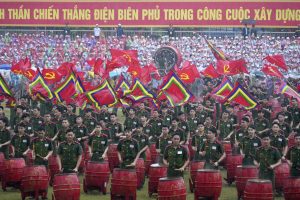On May 7, Vietnam jubilantly celebrated the 70th anniversary of its victory at the battle of Dien Bien Phu, placing the spotlight on the veterans who fought the arduous battle to defeat the French colonialists.
The battle of Dien Bien Phu was a pivotal event in modern Vietnamese history, marking the end of almost a century of French colonial rule in Indochina. This victory is often described as a symbol and inspiration for national liberation and independence movements in other parts of the world.
Following the fall of Dien Bien Phu, the First Indochina War ended with the 1954 Geneva Accords. Under the terms of the Accords, the French agreed to withdraw its forces from French Indochina. Vietnam, however, was temporarily divided into two parts at the 17th parallel. The north was ceded to the Viet Minh, the communist movement that had defeated the French. The South became the State of Vietnam, a nominally independent nation led by Emperor Bao Dai and supported by the United States.
This year’s commemoration of the anniversary of the battle of Dien Bien Phu was notable for the presence of the French Minister of the Armed Forces Sebastien Lecornu. This demonstrated the extent of the reconciliation between the two countries, as well as serving as a reminder of the profound influence that French rule had on Vietnam.
Despite the extremely repressive nature of French rule, the Vietnamese public remains interested in the French heritage left behind in Vietnam, from the Latinized Vietnamese writing system (chu Quoc ngu) to basic infrastructures, architecture, and the formation and urban planning of major cities such as Hanoi, Ho Chi Minh City, and Dalat.
Chu Quoc ngu, which was formulated by the French missionary Alexandre de Rhodes in the seventeenth century, was boosted by a decree signed by Louis Charles Georges Jules Lafont, governor of the French colony of Cochinchina, in 1878. The official implementation came in 1882. This shift helped Vietnam reduce its dependence on Chinese characters, provided the Vietnamese people with their own writing system, increased literacy rates, and facilitated administrative tasks.
Vietnam’s major infrastructure likewise dates from the French period, including National Route 1 and the north-south railway. National Route 1 was built on the north-south Thien Ly Road that had been constructed during the Nguyen Dynasty in the early 19th century. However, after 1913, to complement railway construction, which began in 1899, the French renovated, upgraded, and expanded the existing Thien Ly Road, which had been in use since the Nguyen Dynasty.
These transportation arteries helped integrate the Vietnamese economy and laid the foundation for the unified country of the present day.
Although most buildings from the French colonial era are no longer used as dwelling places, they are admired by the locals for their architectural beauty. Some iconic ones, like the Presidential Palace, are still in use. Other iconic examples of French architecture in Hanoi include the Opera House, the History Museum, and the Long Bien Bridge.
Constructed during 1899-1902, the latter was the first major bridge to cross the Red River. This engineering marvel, featuring a central railway track flanked by pedestrian/bike lanes, ranked among the world’s four largest steel bridges at the time of its construction. Stretching over 2.4 kilometers, it was also one of Asia’s longest. During the Vietnam War, its strategic location as the sole link between Hanoi and the vital port city of Haiphong made it a crucial route and target.
As former Foreign Minister Nguyen Dy Nien once put it, the Long Bien Bridge “not only simply connects the two banks of the Red River but is also a bridge connecting France with Vietnam, connecting the past with the present and the future.” Last year, France decided to provide a non-refundable grant of more than 700,000 euros to conduct a feasibility study to renovate the bridge.
In major Vietnamese cities like Hanoi, Ho Chi Minh City, and Dalat, old French villas remain at the center of a persistent controversy. The debate is not over whether to keep these colonial-era structures, but rather how to best restore them while preserving their historical integrity. Particularly in Hanoi, authorities have selected 92 old French colonial villas for embellishment and preservation. Similar to the Long Bien Bridge restoration project, these villas will likely require assistance from the French government, at least in the form of expert consultation and, potentially, partial financial support similar to the contribution made for a specific old French villa restored in Hanoi in 2023.
Beyond its colonial past, France remains a major donor to Vietnam. In fact, France is Vietnam’s largest European bilateral donor, providing significant financial assistance as the second-largest recipient of French Official Development Assistance (ODA).
Between 1993 and 2022, France committed nearly $18.4 billion in ODA loans. These loans specifically targeted areas crucial for Vietnam’s growth, focusing on the development of infrastructure such as railways and water supply and sanitation projects. This focus aligns with the emphasis on decentralized cooperation between French localities and Vietnamese provinces, which has seen successful collaboration in areas like health, education, and sustainable development since 1990. France’s commitment extends beyond just financial aid. Many French businesses invest in Vietnam, recognizing its potential as a domestic market and a strategic location within the Association of Southeast Asian Nations (ASEAN).
The French colonial legacy in Vietnam remains a subject of debate. While the period undoubtedly left behind deep scars, it’s undeniable that the French also contributed to the foundation of modern Vietnam. Some aspects of this legacy, like infrastructure and architecture and the Quoc ngu writing system, are even a source of pride for many Vietnamese. In the future, France can hope to have a similar impact on Vietnam’s strategic development plans if it can tread carefully around its complex historical legacy.

































